Teaching handwriting to kids with dysgraphia involves modification, remediation, and accommodations. This is how I teach my kids with dysgraphia handwriting.
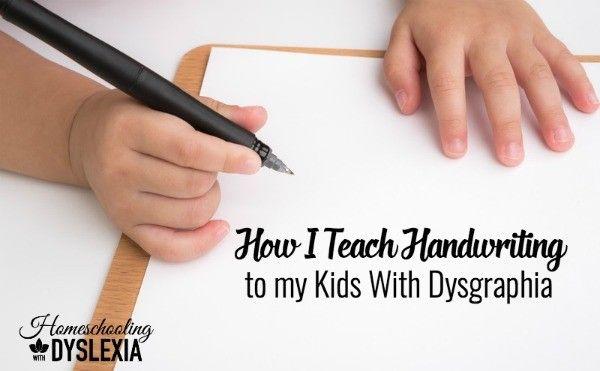
I should have known something was wrong when my 6-year old struggled for weeks to scratch out the 3 letters that made up his name. But as with many first borns, with no other siblings to compare to, I didn’t really know what to expect. I pushed and pushed him to write. I didn’t even know that dysgraphia existed.
Never heard of dysgraphia? People with dysgraphia, for a variety of reasons, have trouble processing what the eye sees or what the ear hears and transferring that information into letters and words.
Dysgraphia effects much more than handwriting alone.
Dysgraphia also affects:
- drawing (and coloring in the younger years)
- grammar and punctuation
- spelling
- composition
This struggle is affected by a variety of skill deficits including:
- poor motor processing skills
- poor fine motor skills and
- visual spatial weaknesses
Read this post for more signs of dysgraphia.
How I Teach Handwriting to my Kids With Dysgraphia
Many years have passed since forcing that 6-year old to write his 3-letter name and I like to think that I’ve learned a thing or two. I have found the best way to teach kids with dysgraphia to write is to start with modifications.
Start With Modifications
Modifications are essentially that. I modify how much and what kinds of writing my kids do. In a traditional school, 5 and 6 year olds are expected to write extensively throughout the day. Handwriting is a part of most classes. It helps a teacher to keep track of assignments and progress.
In the homeschool, this is not necessary.

So in the early years, I limit handwriting primarily to during handwriting instruction. During this time, I start with a salt tray. Create a multi-sensory writing surface by pouring an inch or two of salt into a shallow pan. As I review my early learners phonograms (letter sounds), I have them draw as many letters as they can, without becoming overwhelmed, into the salt. Mistakes are easily shaken away and the multi-sensory component helps aid memory.
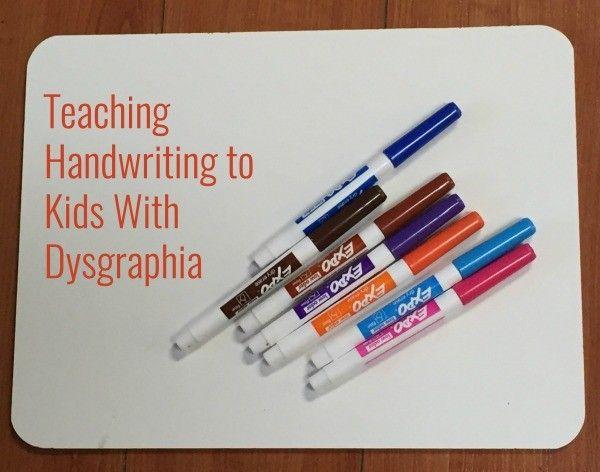
When there is a certain level of mastery here, I move on to a small dry erase board, preferably without lines. This one with lines on one side and is blank on the other. Get some low odor dry erase pens in fun colors and have your child write his letters here for some time. At first, during review time, I would call out a sound and have my child write the corresponding letter. Note: I review letter sounds for a looooooong time so that my dyslexic kids know them automatically.
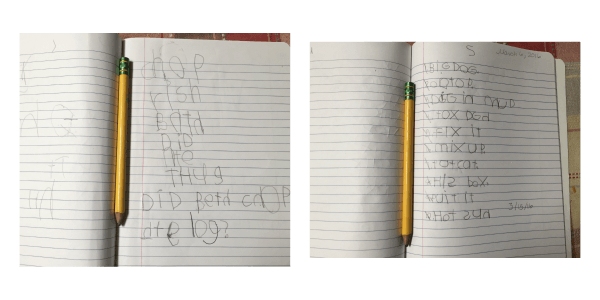
This shows my 8-year old son’s improvement over the course of several months.
Next we graduate to a composition book and fat pencils. During spelling, I dictate between 5-10 words or phrases for my child to write in the book. Let your child choose what size letter is the most comfortable for his or her hand. Not all kids with dysgraphia prefer to write large letters. At this point my kids’ handwriting is still often full of reversals and sometimes a mix of upper and lower case. My goal up to now is to strengthen their hands and not completely overwhelm them with handwriting.
Teaching Cursive
When I feel that my child is fairly comfortable writing his spelling words into his composition book, I transition to cursive instruction. The best program I’ve seen for this is from Logic of English and is called The Rhythm of Handwriting.
This program is highly multi-sensory, beginning with the types of strokes that make up each letter. While writing, the verbal cues for which stroke is being used are spoken.
Read this post to learn more about How and Why I Teach Cursive to my Kids With Dysgraphia.
Remediation for Dysgraphia
I know some of you have been groaning as you read about the modifications that I make for my kids with dysgraphia. Lest you fear that our instruction is too light, all the while we are teaching the early stages of handwriting, we are also focusing on remediation. Remediation is strengthening the foundation that any set of skills are based on. For dyslexia, this would be teaching and reviewing with an Orton-Gillingham based reading program.
For dysgraphia, this involves improving:
- motor skills: both gross or large muscle and fine motor skills
- motor processing skills
- and enhancing visual-spatial awareness
Remediation is the main focus of helping kids with dysgraphia from kindergarten through middle school. Because dysgraphia can be affected by motor skills, visual-spatial skills and processing speeds, there are a wide variety of methods for remediating dysgraphia. If you are looking for ways to remediate your child’s dysgraphia, I highly recommend taking my Parent Class: Teaching Handwriting to Kids With Dysgraphia.
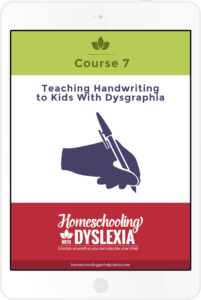 This class takes an in depth look at:
This class takes an in depth look at:
- what dysgraphia is,
- how it affects learning,
- how to modify instruction for kids with dysgraphia
- how to remediate dysgraphia, including:
- ways to enhance visual perception,
- ways to strengthen gross motor skills and motor planning skills
- how to strengthen fine motor skills
- how to strengthen working memory, and
- how to teach kids to organize their writing
- how to implement the best accommodations for kids with dysgraphia
- an extensive list of resources for teaching kids with dysgraphia
Accommodations for Dysgraphia
The last phase of my handwriting instruction involves introducing appropriate accommodations into my kids’ learning.
Accommodations are tools or procedures that allow kids to complete assignments at their grade level at their intellectual ability.
For dysgraphia, this might be:
- dictating written work to a scribe (parent or sibling)
- using some form of speech-to-text program
- allowing school work to be typed
- if in class, allow student to have a designated note-taker
- allowing student to choose cursive or print
- using graph paper for organizing written work
- allowing the use of spell checkers
Accommodations are a big part of helping kids become independent learners. As my kids get more and more fluent with their reading and writing, I transition them into any and all needed accommodations so that they can keep up with their studies and maintain a level of independence in keeping with their age and maturity level.
What You Need to Know About Dysgraphia
Dysgraphia doesn’t reflect a lack of intelligence. Like dyslexia, dysgraphia is not outgrown and varies in severity. Every child is unique and every child’s modifications, remediations and accommodations will be different. You know your child best. The goal of your instruction is to make sure your kids are competent writers and able to express themselves well.
How about you? How have you taught your kids with dysgraphia?
Stay Connected!
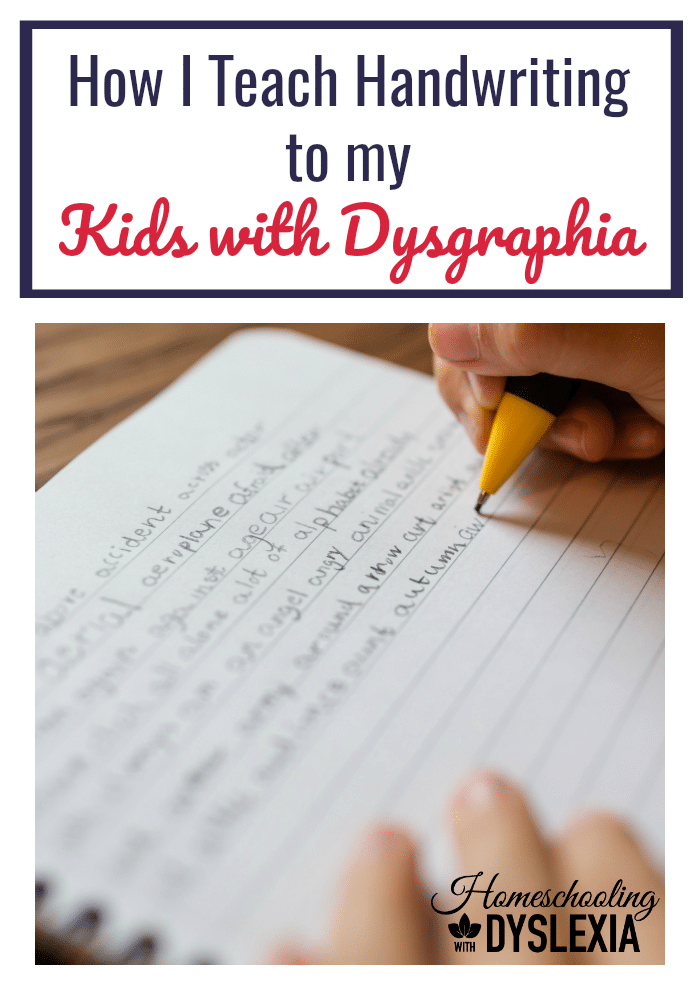

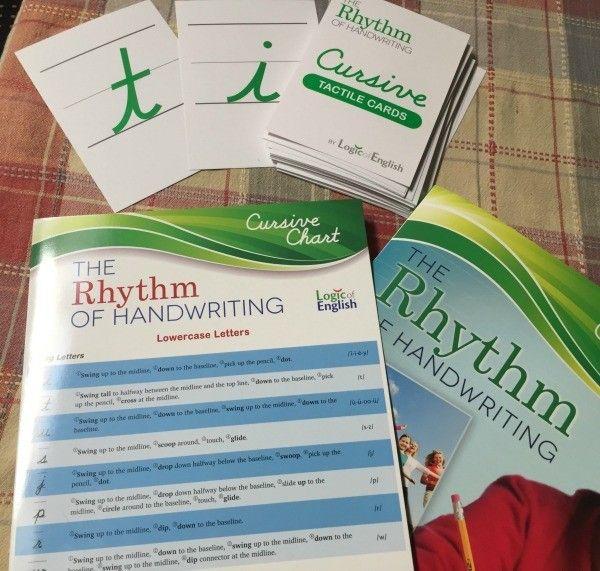





I can’t wait for this class, Marianne. Both of my boys also have dysgraphia – something I didn’t even know was a thing until a few years ago. It is difficult to find resources to help (other than pencil grips at OT). This is much needed!
Thanks Shawna! 🙂
Thank you SOOO much for this!!!! Can’t wait for the class!
I have an 11 year old I suspect has this. He shows almost every sign. One of the things I’ve read that also can help is switching out their lined paper for graph paper, and telling them to leave a blank box in between words and sentences. We haven’t tried this yet, but I may. I also do tons of copywork, and I’m noticing his writing is improving. I’m checking into all about spelling curriculum books to work on spelling and phonics rules. Top it off, I also think he has some degree of dyscalculia. We’ve supplemented math with an abacus recently, to break the habit of finger counting. Again showing some improvement. It’s all trial and error! Thanks for the great post 🙂
Hi! Do you teach the class on teaching your kids handwriting who have Dysgraphia? The link isn’t working and I really hope so!
Yes! Here’s the link:
https://dev.homeschoolingwithdyslexia.com/product/course-7-teaching-writing-to-kids-with-dysgraphia/
How do you test for dysgraphia?
Hi Wanda,
An Occupational Therapist can do the testing. Here’s a link to an article on the tests that are used: http://www.smartkidswithld.org/first-steps/evaluating-your-child/evaluating-your-child-for-dysgraphia/
When I started teaching 40 years ago (haven’t taught for many years now), learning about learning disabilities was fairly new. In my very first class I had a boy with high intelligence who only turned in scribbled work. I didn’t know about dysgraphia until several years later, and I have always felt bad that I blamed him rather than helped him. I do hope he got the help he needed in later years.
Do not be timid about spelling with your first grader. Check out Moats, Speech to Print. I wish I had read this years ago! Or maybe a year ago. Enlightening, and so true!!
We had my 13 yo tested when he was 10. He has severe dysgraphia. We tried OT, but it compounded his issues. We use Getty Dubay Italics, but I’m wondering if I should switch to the handwriting program you mentioned. What would you recommend for a 13 year old? He is a competent typist, and I have had him focus on his signature. I’m tempted to just let handwriting go. The psychologist who did his testing recommended not bothering with handwriting, but I never could bring myself to drop it. At 13, there are many other areas of academics he should be focusing on at this point, so I’m trying to balance out the cost/benefit of remediation,,,
Your question is very familiar to me Jennifer! Looking to the future, what are some practical goals for your son? Can he print well enough to fill out forms and write simple letters and notes? Having beautiful penmanship may not be in his future. You have to decide what is the most important thing for him in his unique situation. I have heard of parents who were able to teach their kids to write in cursive well, but they still preferred to print or type!
Dear A,
Thanks for sharing. Don’t drop the handwriting.
I have a 15 yr old with both dys’es. Finding what works, and what to drop, is a fine and often confusing line. I taught him with GD, too, but wished I hadn’t for he can’t read our nations historical documents!
A case to make for teaching classic American cursive is important for two reasons. It’s vital for note-taking skills in lectures. Research suggests that handwritten notes from a lecture better support memory retention of the material, over keyboarding the notes on a lap top. Also, cursive is faster to write than printing. Second, my son can’t cypher the text of our nation’s historical documents, because I taught him to write with GD. One MUST be able to read those documents for oneself, in order to know the truth contained therein! Think how vulnerable this next generation will be to deceptions regarding the content of these documents, simply because they can’t decipher the loops into words. Thinking about that reality makes me shudder.
Hang in there.
Hi there – is the evidence about note-taking generic or does it specifically apply to kids with dysgraphia?
Specifically to kids with dysgraphia!
It is actually not specifically for kids with dysgraphia. Studies have found this to be true for everyone.
My 13 yr old was just diagnosed add inattentive type, severe dyscalclia, and dysgraphia. I am a bit overwhlemed. The neuropsych dr told me to put him in special ed at public school. Ive been homeschooling but feel like im failing miserably in these areas. My other son has ehlers danlos syndrome and along list of other diagnoses that keep me constantly going to appts and trying to manage his care. I am doing my very best but i feel like im almost ready to throw in the towel and say im just not cut out to do all that i am trying to do. Theres just not enough time in the day to figure all this out too on top of everything else. The problem is im trying to teach them like “normal” children with no disabilities because i dont know how to teach any differently. I dont know even know where to begin to find what curriculum to use to break thru these barriers. Any advice for a struggling overwhelmed mama?
You’ll want to try to outsource some of their teaching if possible. An educational therapist (we love NILD) can help take a load off of you. Our kids who struggle with math go to Mathnasium – a group tutoring center that is very good. We joined a homeschool charter school this year to help pay for that. Also you’ll want to start using accommodations like assistive technology. These help kids work independently. Things like speech-to-text and text-to-speech, audio books and math apps can help kids have the support they need.
My son is now 21 and we just recently realized he has dysgraphia. While homeschooling him I always thought writing would eventually get easier for him as he matured but it never did. I feel horrible for not addressing this when he was younger but I was ignorant. He is very intelligent but his awful and painful handwriting bothers him. What can we do now?
Thank you.
I would get him involved in assistive technology like speech to text apps, Siri, etc. He can use those for work arounds.
My 8 year old boy has been diagnosed with dysgraphia ( seems like a lot of boy mamas here). He has struggled with printing since the beginning of school. In addition to OT to strengthen his core, we see a HWT handwriting specialist. We are starting cursive next week! I am so hopeful that this will help improve his writing skills and self confidence. He is such a smart creative little guy that loves to make up stories. Keyboarding is another skill we are working on, but We are both excited about cursive. Let you know how it goes….
What do you recommend for a spelling program for kids who have dysgraphia but not dyslexia? All four of mine read at or above grade level but the three oldest are below grade level in spelling.
Hi Christine. Most reading programs include a spelling element. Since your kids are not struggling with reading here are some ideas for helping them with their spelling.
https://dev.homeschoolingwithdyslexia.com/homeschool-spelling-curriculum-students-dyslexia/
How do I find someone who specializes in visual- spatial awareness? I think this is my son’s issue, who has dysgraphia. No dyslexia here.
Thanks
What do you do about the spelling issues with dysgraphia? Handwriting is helpful but my son struggles with spelling even orally?
Spelling is the last skill to fully develop and many adults with dyslexia rely on assistive technology to get by. All About Spelling is awesome as is any good Orton-Gillingham reading program. They need a LOT of practice.
I suspect that my 9 year old son has a dysgraphia. We did vision therapy that helped him with reading, but his writing is awful (reversals, problems with spelling, no space between word). But the worst so far is his struggle with putting his thoughts on paper. What do you do about composition issues in kids with dysgraphia?
I try to help them with brainstorming their ideas by asking questions. I also have used a mind map to help them organize their thoughts on paper.